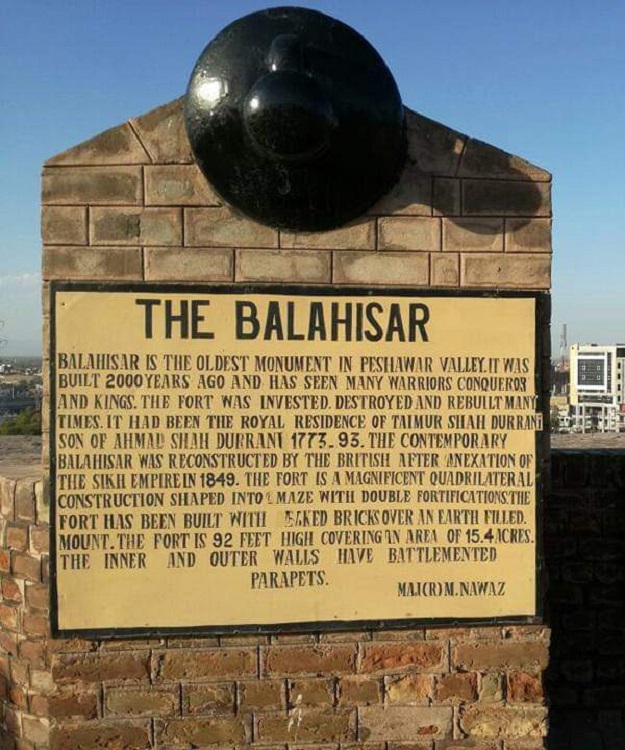Balahisar Fort: A Symbol Of South Asian History
News Desk
Peshawar: Peshawar, one of the oldest continuously inhabited cities in South Asia, has long possessed strategic importance due to its geographical location and been a source of attraction for invaders looking to establish and fortify their dynasties.
The architectural marvel has always been a major draw for both domestic and international visitors, dignitaries, and tourists, offering a unique view of its massive battlements and architectural designs. With a history spanning more than 2,500 years, the city was crucial to all kings, rulers, soldiers and invaders that dominated this area since it served as a gateway to the subcontinent.
Therefore, these kings built forts across the subcontinent as their political strongholds to ensure the protection of their subjects and protect them from outside attack, notably the massive Balahisar Fort.

Situated opposite Jinnah Park (the old Cunningham Park) on main GT Road, Balahisar spreads over an area of 15.4 acres and is built of red bricks with 92 feet in height. The rich lands of the subcontinent serve as a reminder to visitors of the rulers of various dynasties who resided here before marching there to obtain commercial and geopolitical benefits.
“In the past, most of the invaders and warriors, including Afghan Muslim rulers, Mughals, Sikhs, and British, used to first conquer Balahisar fort before proceeding to Punjab and other parts of the subcontinent,” said KP Archaeology and Museums Department Senior Research Officer (SRO) Bakhtzada Khan.
Bakhtzada Khan told that recent excavations at Gor-Kathri in Peshawar have shown the existence of a metropolis with a 2,500-year antiquity. However, describing this history would be lacking without bringing up the famed Balahisar fort. It appeared to be at least as old as Peshawar itself.
The original main entrance of Balahisar is just in front of the GT road, which runs from Pushkalavati (Charsadda) in the north to Hund and Taxila in the east and connects Peshawar with Afghanistan and Central Asia on the west.
There used to be several branches of the former Bara River that went through the centre of Peshawar, one of which was probably close to the Balahisar Fort.
Renowned historian, Dr A.H. Dani, wrote in his book ‘Peshawar: The Historic City of Frontier’ (now Khyber-Pakhtunkhwa) that when Hiuen Tsang, a Chinese traveller, visited Peshawar in 630 AD, he spoke of a “royal residence,” i.e., Balahisar.

According to Dr Dani, a channel of the old Bara River surrounded by a high spot perhaps comprised Balahisar and InderShahr, and the present elevated Balahisar could have been the citadel.
The Chinese term ‘Kung Shing’ is employed for emphasis, and it is defined as the walled or fortified area of a town where the royal palaces once stood. This demonstrates that the royal palace served as the core of a citadel, which was further fortified by a moat.
Historical Background: In the 11th century AD, Raja Jaipal, a ruler of the Hindushahi dynasty, was defeated in Peshawar’s vicinity, and CommanderMehmudGhaznavi had garrisoned the fort with his army.
There were different opinions about the origin of the fort, but mostly Mughals were believed to be the architects of present-day Balahisar, SRO Bakhtzada said.
According to renowned historian AbulFazl, Balahisar was redesigned and built by Mughal emperor Zaheeruddin Babar in 1526. However, after overthrowing Emperor Humayun by ShershahSuri, the Afghans destroyed the fort.
“Hamyun made the decision to restore the fort while he was residing there in order to use it for his eventual invasion of India, and he personally oversaw its reconstruction. During the Sikh era, Hari Singh Nalwa also utilised Balahisar as Maharaja Ranjeet Singh’s regal home,” Senior Research Officer stated.
“Early in the 19th century, the Afghan Durrani rulers used it as their winter camp and gave it the Persian name ‘Balahisar,’ which means ‘high fort’.Samargarh was later given by Sikhs in 1834, but the name was never particularly well liked,” SRO Khan added.
Balahisar remained a key settlement for successive rulers and witnessed the rule of Hindu Maharajas, Ghauris, Ghazanvis, Tughlaqs, Mughals, and Sikhs.
The fort also remained the residence of the Afghan king, Ahmed Shah Durrani, and his son, Taimur Shah Durrani. However, after the death of the latter in 1793 AD, the Durrani rule weakened, and the Sikhs captured Peshawar and Balahisar in 1834 after the battle of Nowshera.
Firstly, the Sikhs destroyed a major portion of the fort but later regretted it, and Sher Singh, on orders of his father, Ranjeet Singh, erected the fort with unbaked bricks. At the time of Sikh Shahi annexation by British rulers in 1849, Balahisar had mud walls. The British replaced its structure with red bricks in its present shape and kept troops in Balahisar till the cantonment was laid out in Peshawar.
On August 14, 1947, Balahisar also had the privilege of raising the flag of the country, and it afterwards served as the headquarters of the Frontier Corps (FC).
The feature has been filed in APP and reproduce by the PenPK.com
Photo Credit: Express file

Comments are closed.